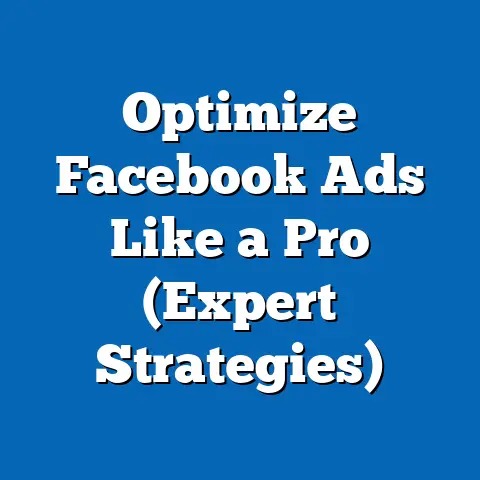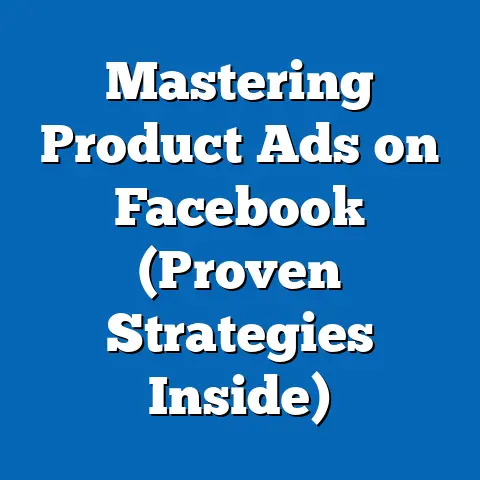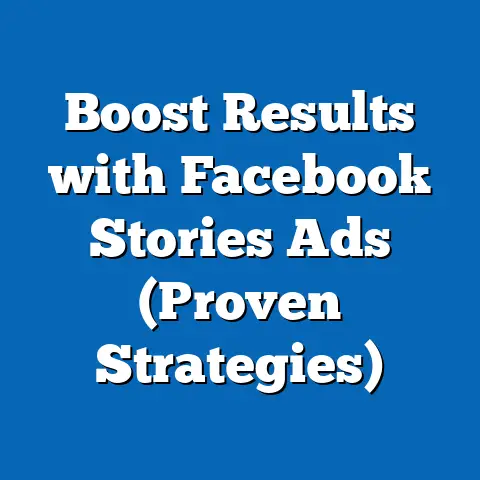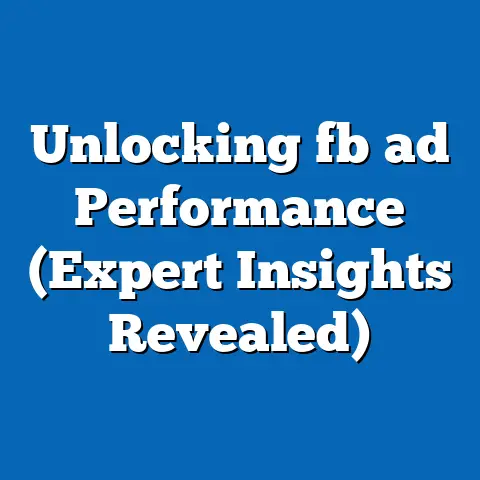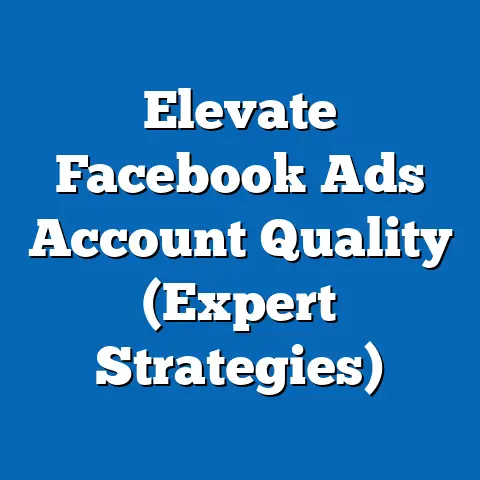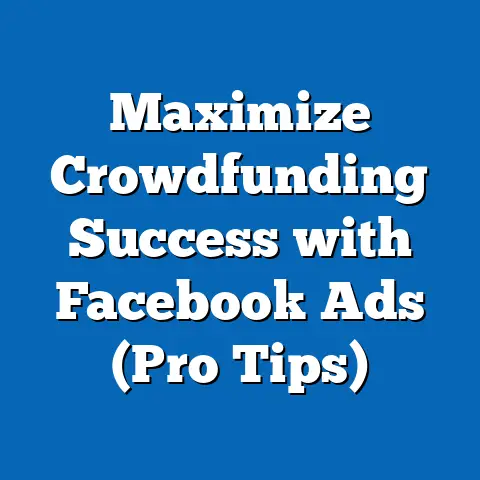Boost Engagement with Scrolling Facebook Ads (Expert Tips)
In today’s whirlwind digital landscape, we’re all bombarded with information. Our lives move fast, and we’re constantly seeking solutions that fit seamlessly into our daily routines. From quick and healthy meal options to convenient entertainment on the go, consumers crave products and services that cater to their specific lifestyle needs. As advertisers, it’s our job to meet them where they are, and that’s often right in the middle of their Facebook scroll.
Scrolling Facebook ads, when done right, are a powerful tool to capture attention and drive meaningful interaction. Think about it: you’re casually browsing, catching up with friends, and then BAM! An ad stops you in your tracks. It’s not just another interruption; it’s relevant, engaging, and speaks directly to your needs. That’s the power we’re aiming for.
In this guide, I’m going to share expert tips that will help you create scrolling Facebook ads that resonate with your target audience. We’ll dive into the psychology behind scrolling, craft compelling visuals, write engaging copy, target the right audience, and, most importantly, test and optimize everything for maximum impact. Get ready to create ads that not only get noticed but also drive brand loyalty and sales. Let’s get started!
Section 1: Understanding the Scrolling Behavior
Let’s face it, we’re all guilty of endless scrolling. It’s almost a reflex. But understanding the why behind this behavior is crucial for crafting effective Facebook ads.
The Psychology of the Scroll
Scrolling on social media is more than just a pastime; it’s a psychological phenomenon. It’s tied to the release of dopamine, the “feel-good” neurotransmitter in our brains. Every new post, every new image, is a potential reward, keeping us hooked and scrolling for more.
This constant stream of information also creates a sense of FOMO (Fear of Missing Out). We don’t want to miss the latest updates, the trending topics, or the funny memes. This fear drives us to keep scrolling, even when we know we should be doing something else.
Data on Scrolling Times and Ad Interaction
So, how much time are people actually spending scrolling? Studies show that the average user spends around 34 minutes per day on Facebook alone. That’s a significant chunk of time, but it also means a lot of competition for attention.
According to a recent study by Statista, the average click-through rate (CTR) for Facebook ads across all industries is around 0.9%. While this may seem low, it highlights the importance of creating ads that stand out from the crowd. We need to grab attention quickly and maintain engagement throughout the entire ad experience.
Grabbing Attention Quickly
With so much content vying for attention, you have mere seconds to make an impression. Here’s where understanding your audience’s lifestyle needs comes into play. What are their pain points? What are their aspirations? Your ad needs to immediately address these factors.
- Visual Hook: Use a striking image or video that immediately catches the eye.
- Compelling Headline: Craft a headline that is concise, intriguing, and relevant to their interests.
- Clear Value Proposition: Communicate the benefits of your product or service upfront.
Examples of Effective Scrolling Ads
I’ve seen countless ads that fall flat, but the ones that truly succeed understand the nuances of scrolling behavior.
- Example 1: Dollar Shave Club – Their ads often feature short, humorous videos that immediately grab attention. They understand that people are scrolling for entertainment, so they inject humor into their marketing. The ads are also concise and clearly communicate the value proposition: affordable razors delivered to your door.
- Example 2: Airbnb – Airbnb uses stunning lifestyle imagery in their ads, showcasing unique properties in desirable locations. This taps into people’s desire for travel and new experiences. The ads often feature real people enjoying their stays, creating a sense of relatability and aspiration.
- Example 3: MasterClass – MasterClass leverages the star power of their instructors to grab attention. Their ads feature short clips of celebrities teaching their craft, appealing to people’s desire for self-improvement and learning. The ads are also highly targeted, showing instructors relevant to the user’s interests.
Takeaway: Understanding scrolling behavior is the foundation for creating effective Facebook ads. By grabbing attention quickly and maintaining engagement throughout the ad, you can cut through the noise and connect with your target audience.
Section 2: Crafting Compelling Visuals
Visuals are the cornerstone of any successful Facebook ad. In a sea of text and images, your visuals need to be eye-catching, relevant, and aligned with your target audience’s lifestyle needs.
The Significance of High-Quality Visuals
Think of your Facebook ad as a digital billboard. You have a limited amount of space and time to make an impression. High-quality visuals are essential for capturing attention and communicating your message effectively.
According to a study by HubSpot, 90% of information transmitted to the brain is visual, and visuals are processed 60,000 times faster in the brain than text. This underscores the importance of investing in high-quality visuals that resonate with your target audience.
Best Practices for Eye-Catching Images and Videos
- Use High-Resolution Images: Avoid blurry or pixelated images. Invest in professional photography or use high-quality stock photos.
- Optimize for Mobile: Most Facebook users are on mobile devices, so make sure your visuals look great on smaller screens.
- Use Bright Colors: Bright colors can help your ad stand out from the crowd. However, be mindful of your brand colors and avoid using colors that clash.
- Showcase Your Product in Action: Instead of simply showing your product, demonstrate how it can be used to solve a problem or improve someone’s life.
- Use Video to Tell a Story: Video is a powerful medium for storytelling. Create short, engaging videos that showcase your brand’s personality and values.
Color Psychology and Design Principles
Color psychology plays a significant role in how people perceive your brand. Different colors evoke different emotions and associations.
- Blue: Trust, security, stability
- Green: Nature, health, growth
- Yellow: Optimism, energy, happiness
- Red: Excitement, passion, urgency
When designing your Facebook ads, consider your target audience’s preferences and the message you want to convey. Use colors that align with your brand identity and evoke the desired emotions.
In addition to color psychology, it’s also important to follow basic design principles.
- Balance: Create a sense of visual equilibrium by distributing elements evenly throughout the design.
- Contrast: Use contrasting colors and fonts to create visual interest and highlight key elements.
- Hierarchy: Guide the viewer’s eye through the design by using different sizes and weights for text and images.
- White Space: Use white space to create breathing room and prevent the design from feeling cluttered.
Utilizing User-Generated Content and Lifestyle Imagery
User-generated content (UGC) is a powerful tool for creating relatability and building trust. When people see real customers using and enjoying your product, they’re more likely to believe the hype.
- Run a Contest: Encourage customers to submit photos or videos of themselves using your product.
- Feature Customer Testimonials: Share positive reviews and testimonials in your ads.
- Partner with Influencers: Collaborate with influencers to create authentic content that resonates with their followers.
Lifestyle imagery is another effective way to connect with your target audience. Instead of simply showing your product in a studio setting, showcase it in real-life situations that your target audience can relate to.
- Example: A fitness brand could show people using their products while hiking, running, or doing yoga.
- Example: A travel brand could show people enjoying their vacations in exotic locations.
Takeaway: Compelling visuals are essential for capturing attention and driving engagement on Facebook. By using high-quality images and videos, understanding color psychology and design principles, and utilizing user-generated content and lifestyle imagery, you can create ads that resonate with your target audience and achieve your marketing goals.
Section 3: Writing Engaging Copy
While visuals grab the initial attention, it’s the ad copy that seals the deal. Your copy needs to be concise, compelling, and speak directly to your target audience’s lifestyle needs.
The Role of Ad Copy in Facilitating Engagement
Ad copy serves several important functions:
- Clarifies the Value Proposition: Explains the benefits of your product or service in a clear and concise manner.
- Creates an Emotional Connection: Connects with the audience on an emotional level by addressing their pain points and aspirations.
- Drives Action: Encourages the audience to take a specific action, such as clicking on the ad, visiting your website, or making a purchase.
Techniques for Writing Concise, Compelling Headlines
Your headline is the first thing people will see, so it needs to be attention-grabbing and relevant.
- Keep it Short and Sweet: Aim for a headline that is no more than 25 characters long.
- Use Strong Verbs: Use action verbs that create a sense of urgency and excitement.
- Highlight the Benefits: Focus on the benefits of your product or service, rather than the features.
- Ask a Question: Pose a question that piques the audience’s curiosity and encourages them to click on the ad.
- Use Numbers and Statistics: Numbers and statistics can add credibility and make your headline more attention-grabbing.
Storytelling in Ad Copy
Storytelling is a powerful tool for creating an emotional connection with your audience. By telling a story, you can transport them to another world and make them feel like they’re part of something bigger.
- Identify Your Audience’s Pain Points: What are the challenges and frustrations that your target audience faces?
- Create a Relatable Character: Create a character that your target audience can identify with.
- Tell a Story of Transformation: Show how your product or service can help your character overcome their challenges and achieve their goals.
- Use Vivid Language: Use descriptive language that paints a picture in the reader’s mind.
- End with a Call to Action: Encourage the reader to take a specific action, such as visiting your website or making a purchase.
Examples of Effective Ad Copy
- Example 1: “Tired of Shaving Every Day? Get Smooth Skin in Minutes!” – This headline is concise, benefit-driven, and uses a strong verb (“Get”). It speaks directly to people who are tired of the hassle of shaving.
- Example 2: “Struggling to Lose Weight? Discover the Secret to Lasting Weight Loss!” – This headline asks a question, highlights the benefit (lasting weight loss), and creates a sense of mystery (“the secret”).
- Example 3: “Join Thousands of People Who Are Living Their Best Lives with Our Productivity App!” – This headline uses social proof (“Thousands of people”) and highlights the benefit (living their best lives).
Takeaway: Engaging ad copy is essential for converting clicks into customers. By writing concise, compelling headlines, telling stories that resonate with your audience, and using a clear call to action, you can create ads that drive results.
Section 4: Targeting the Right Audience
You can have the most visually stunning and engaging ad in the world, but if you’re showing it to the wrong people, it’s not going to be effective. Audience targeting is crucial for maximizing your advertising ROI and ensuring that your ads reach the people who are most likely to be interested in your product or service.
The Importance of Audience Targeting
Audience targeting allows you to narrow down your audience based on a variety of factors, such as demographics, interests, behaviors, and connections. This ensures that your ads are only shown to people who are likely to be interested in what you have to offer.
- Increased Relevance: Targeted ads are more relevant to the audience, which leads to higher engagement rates.
- Lower Costs: By targeting the right audience, you can reduce your ad spend and increase your ROI.
- Improved Conversion Rates: Targeted ads are more likely to convert into sales or leads.
Targeting Options on Facebook
Facebook offers a wide range of targeting options, allowing you to create highly specific audiences.
- Demographics: Target people based on age, gender, education, relationship status, and location.
- Interests: Target people based on their interests, hobbies, and pages they’ve liked.
- Behaviors: Target people based on their online behavior, such as purchase history and device usage.
- Connections: Target people who are connected to your Facebook page or event.
- Custom Audiences: Upload a list of your existing customers or website visitors to create a custom audience.
- Lookalike Audiences: Create a lookalike audience based on your existing customers or website visitors.
Audience Segmentation
Audience segmentation involves dividing your audience into smaller groups based on shared characteristics. This allows you to tailor your ads to meet the specific needs and preferences of each segment.
- Example: A clothing retailer could segment their audience based on age, gender, and style preferences. They could then create different ads for each segment, showcasing clothing that is relevant to their interests.
Case Studies: Successful Niche Targeting
- Case Study 1: A local bakery used Facebook targeting to reach people who lived within a 5-mile radius of their store and had an interest in baking and desserts. This resulted in a significant increase in foot traffic and sales.
- Case Study 2: A fitness studio used Facebook targeting to reach people who were interested in weight loss, healthy eating, and fitness. They created a custom audience based on their existing customers and then created a lookalike audience to reach new potential customers. This resulted in a significant increase in leads and memberships.
Takeaway: Effective audience targeting is essential for maximizing your advertising ROI. By using the various targeting options available on Facebook and segmenting your audience based on shared characteristics, you can create ads that are highly relevant to your target audience and drive results.
Section 5: Testing and Optimizing Ads
No matter how great your visuals, copy, and targeting are, your Facebook ads are never truly “done.” Continuous testing and optimization are essential for improving performance and maximizing your ROI.
A/B Testing: The Key to Optimization
A/B testing, also known as split testing, involves creating two or more versions of your ad and showing them to different segments of your audience. By comparing the performance of each version, you can identify which elements are most effective and make data-driven decisions about how to improve your ads.
- Test Different Headlines: Try different headlines to see which ones resonate most with your audience.
- Test Different Visuals: Experiment with different images and videos to see which ones capture the most attention.
- Test Different Ad Copy: Try different ad copy to see which messages are most persuasive.
- Test Different Calls to Action: Experiment with different calls to action to see which ones drive the most clicks.
- Test Different Targeting Options: Try different targeting options to see which audiences are most responsive.
Key Metrics to Monitor
- Reach: The number of people who saw your ad.
- Impressions: The number of times your ad was displayed.
- Click-Through Rate (CTR): The percentage of people who clicked on your ad.
- Cost Per Click (CPC): The average cost of each click on your ad.
- Conversion Rate: The percentage of people who took a desired action after clicking on your ad (e.g., making a purchase, filling out a form).
- Cost Per Acquisition (CPA): The average cost of acquiring a new customer.
- Return on Ad Spend (ROAS): The amount of revenue generated for every dollar spent on advertising.
Iterating on Ad Designs and Copy Based on Performance Data
Once you’ve collected enough data from your A/B tests, it’s time to analyze the results and make data-driven decisions about how to improve your ads.
- Identify Winning Elements: Determine which headlines, visuals, ad copy, and calls to action performed best.
- Iterate on Your Designs: Incorporate the winning elements into your ad designs and create new variations to test.
- Refine Your Targeting: Adjust your targeting options based on the performance of different audiences.
- Continuously Monitor and Optimize: Keep a close eye on your key metrics and continue to test and optimize your ads over time.
Tools and Resources for Testing
- Facebook Ads Manager: Facebook’s built-in ad management platform provides tools for creating and running A/B tests.
- Google Analytics: Google Analytics can be used to track website traffic and conversions from your Facebook ads.
- Third-Party Testing Tools: There are a variety of third-party testing tools that can help you automate the A/B testing process.
Takeaway: Testing and optimization are essential for maximizing your Facebook advertising ROI. By using A/B testing to identify winning elements, monitoring key metrics, and continuously iterating on your designs, you can create ads that drive results.
Conclusion
Creating engaging scrolling Facebook ads that resonate with your audience is an ongoing process. It requires a deep understanding of scrolling behavior, compelling visuals, engaging copy, precise targeting, and continuous testing and optimization.
Remember, your ads are not just advertisements; they are opportunities to connect with people on a deeper level, understand their lifestyle needs, and offer them solutions that improve their lives. By implementing the expert tips I’ve shared in this guide, you can boost engagement, drive results, and achieve your marketing goals.
Don’t be afraid to experiment, to try new things, and to learn from your mistakes. The world of Facebook advertising is constantly evolving, so it’s important to stay curious, stay creative, and stay committed to delivering value to your audience. With the right approach, your Facebook ads can become a powerful tool for building brand loyalty, driving sales, and achieving long-term success. Now go out there and create some amazing ads!

